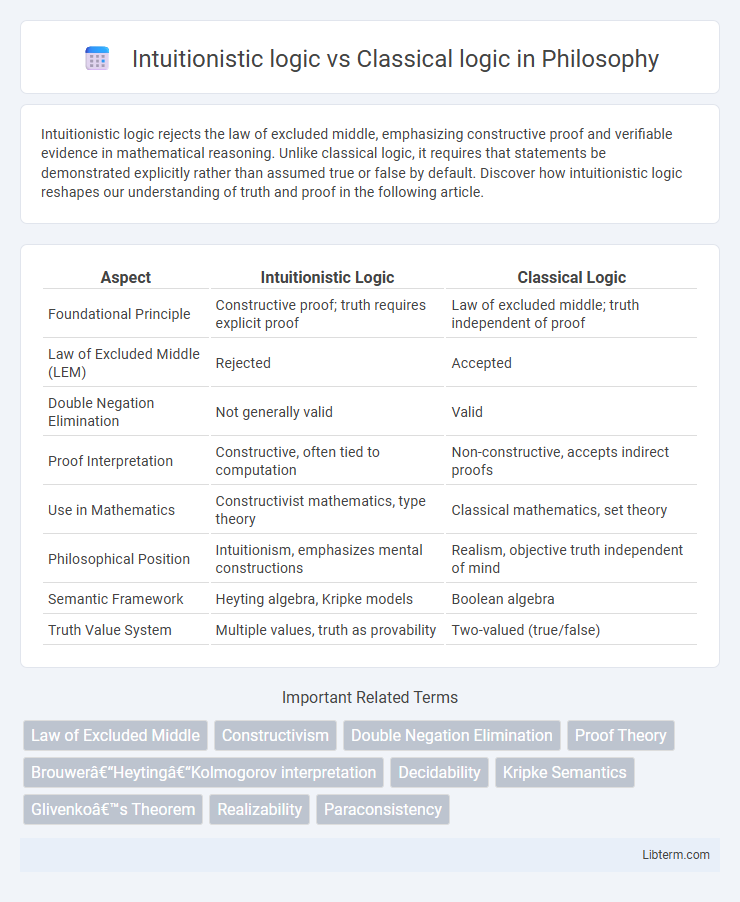Intuitionistic logic rejects the law of excluded middle, emphasizing constructive proof and verifiable evidence in mathematical reasoning. Unlike classical logic, it requires that statements be demonstrated explicitly rather than assumed true or false by default. Discover how intuitionistic logic reshapes our understanding of truth and proof in the following article.
Table of Comparison
| Aspect | Intuitionistic Logic | Classical Logic |
|---|---|---|
| Foundational Principle | Constructive proof; truth requires explicit proof | Law of excluded middle; truth independent of proof |
| Law of Excluded Middle (LEM) | Rejected | Accepted |
| Double Negation Elimination | Not generally valid | Valid |
| Proof Interpretation | Constructive, often tied to computation | Non-constructive, accepts indirect proofs |
| Use in Mathematics | Constructivist mathematics, type theory | Classical mathematics, set theory |
| Philosophical Position | Intuitionism, emphasizes mental constructions | Realism, objective truth independent of mind |
| Semantic Framework | Heyting algebra, Kripke models | Boolean algebra |
| Truth Value System | Multiple values, truth as provability | Two-valued (true/false) |
Introduction to Intuitionistic and Classical Logic
Intuitionistic logic, rooted in constructivist philosophy, rejects the law of excluded middle and demands proof of existence, emphasizing verifiable constructions over abstract truth values. Classical logic operates on bivalent truth values, accepting principles like the law of excluded middle and double negation elimination, enabling broader inferential rules. Both frameworks form foundational systems in mathematical logic, influencing areas such as proof theory, type theory, and computer science.
Historical Development and Philosophical Roots
Intuitionistic logic, developed by L.E.J. Brouwer in the early 20th century, arose as a response to the classical logic framework, emphasizing constructive proof and rejecting the law of excluded middle. Classical logic, rooted in Aristotle's syllogistic reasoning and formalized by Frege and Boole in the 19th century, relies on bivalence and non-constructive principles. Philosophically, intuitionistic logic aligns with constructivism, focusing on provability and mental constructions, whereas classical logic is founded on classical realism and truth values independent of human knowledge.
Fundamental Principles of Classical Logic
Classical logic is founded on the principles of bivalence and the law of excluded middle, asserting that every proposition is either true or false, with no third option. It employs the principle of non-contradiction, ensuring that a statement and its negation cannot both be true simultaneously. These fundamental principles contrast with intuitionistic logic, which rejects the law of excluded middle and emphasizes constructive proof, leading to differences in truth evaluation and proof theory.
Core Tenets of Intuitionistic Logic
Intuitionistic logic rejects the law of excluded middle, emphasizing proof construction over truth values, and requires constructive evidence for assertions, distinguishing it fundamentally from classical logic. It prioritizes provability and constructive proofs, where a statement is true only if there is a constructive proof, rather than relying on abstract truth assignments. Core tenets include the insistence that the meaning of logical connectives is given by the rules for their use in proofs, reflecting a computational interpretation aligned with constructive mathematics.
Truth Values: Bivalence vs. Constructivism
Intuitionistic logic rejects the classical principle of bivalence, positing that truth values are not limited to simply true or false but depend on constructive proof. Unlike classical logic, where every statement is either true or false regardless of evidence, intuitionistic logic demands explicit construction or verification for truth attribution. This emphasis on constructivism leads to a more nuanced semantic framework that aligns with computational interpretations and constructive mathematics.
Law of Excluded Middle: Acceptance and Rejection
Intuitionistic logic rejects the Law of Excluded Middle, which states that every proposition is either true or false, emphasizing constructive proof where existence requires explicit construction. Classical logic accepts this law unconditionally, supporting proof by contradiction and allowing propositions to be classified without direct evidence. This fundamental difference causes intuitionistic logic to be more restrictive, impacting areas like type theory and constructive mathematics.
Proof Techniques and Constructive Reasoning
Intuitionistic logic emphasizes constructivist proof techniques where the existence of a mathematical object is demonstrated by explicitly constructing it, contrasting with classical logic's reliance on the law of excluded middle and non-constructive proofs. Proofs in intuitionistic logic avoid reductio ad absurdum unless a constructive witness is provided, ensuring all validated propositions correspond to constructive evidence. This approach enhances constructive reasoning by aligning proofs with computational interpretations, such as the Curry-Howard correspondence, making intuitionistic logic fundamental in areas like type theory and functional programming.
Applications in Mathematics and Computer Science
Intuitionistic logic, fundamental in constructive mathematics, excludes the law of excluded middle, enabling proofs that construct explicit examples and algorithms, crucial in type theory and proof assistants like Coq and Agda. Classical logic, allowing principles like double negation elimination, underpins traditional mathematical proofs and automated theorem proving systems such as Z3 and SMT solvers, supporting broad reasoning tasks. The distinction enhances functional programming languages and verification methods by aligning with computational interpretations in intuitionistic frameworks and classical reasoning in symbolic computation.
Major Differences and Implications
Intuitionistic logic rejects the law of excluded middle, meaning propositions are only true if explicitly proven, contrasting with classical logic's acceptance of binary truth values. This difference results in intuitionistic logic supporting constructive proofs, impacting fields like type theory and computer science, where proof relevance and algorithm extraction are crucial. Classical logic allows non-constructive proofs, making it less restrictive but less suitable for computational interpretations and constructive mathematics.
Conclusion: Choosing Between Logics
Choosing between intuitionistic logic and classical logic depends on the context of application and philosophical stance regarding truth and proof. Intuitionistic logic emphasizes constructive proof and disallows the law of excluded middle, making it suitable for areas like computer science and formal verification where explicit construction of evidence is crucial. Classical logic, endorsing bivalence and the law of excluded middle, remains widely used in mathematics and everyday reasoning for its simplicity and comprehensive expressive power.
Intuitionistic logic Infographic

 libterm.com
libterm.com